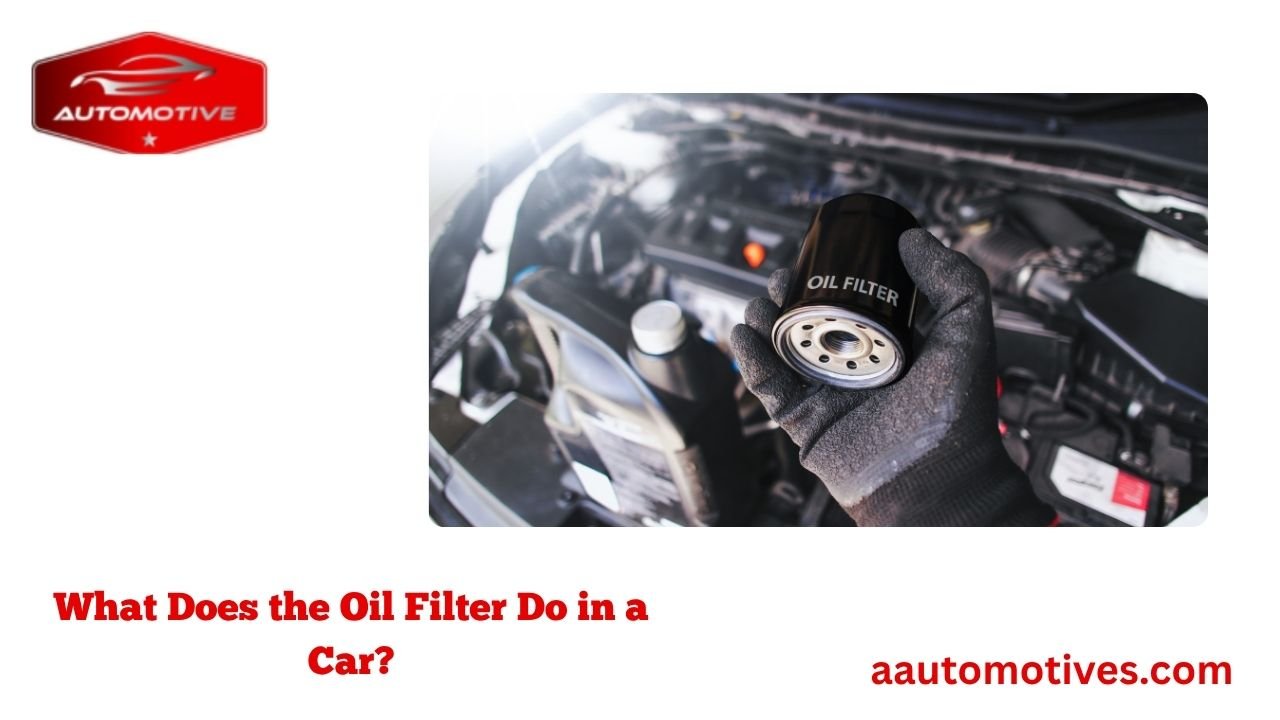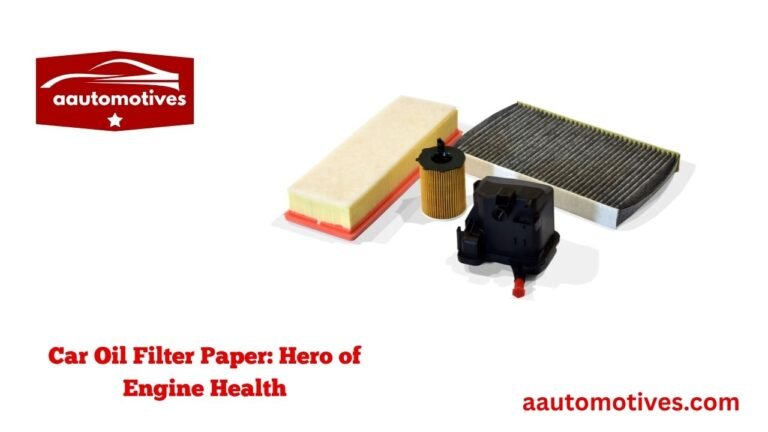What Does the Oil Filter Do in a Car?

Ever been on a road trip, music on full blast, the sun setting just right, and your car running so smooth it feels like butter on toast? That peace-of-mind moment? You owe part of it to a little thing most people never think about — the oil filter. Now, you might be wondering, what does the oil filter do in a car anyway?
Well, buckle up. We’re about to take a ride under the hood and see how this small part plays a huge role in keeping your engine healthy, clean, and running like a dream.
I used to ignore this stuff myself — until I learned the hard way. A few years ago, I skipped an oil change or two, thinking, “What’s the worst that can happen?” Turns out, a dirty oil filter is like trying to breathe through a clogged straw. The car started knocking, overheating, and guzzling fuel. That’s when I realized this tiny component deserved a little more respect.
In This Article
- 1 The Oil Filter: Small Part, Massive Responsibility
- 1.1 A Closer Look at How the Oil Filter Works
- 1.2 Why a Dirty Oil Filter is a Silent Engine Killer
- 1.3 How Often Should You Change Your Oil Filter?
- 1.4 Types of Oil Filters and What They Mean for Your Ride
- 1.5 Long-Term Benefits of a Healthy Oil Filter
- 1.6 The Emotional Side of Maintenance: Love Your Ride
- 1.7 DIY vs. Mechanic: Changing Your Oil Filter
- 1.8 Price vs. Performance: Is the Cheap Filter Worth It?
- 1.9 Engine Health Is a Reflection of Life Habits
- 1.10 Recap: The Oil Filter, a Little Part With a Big Purpose
- 1.11 Final Thoughts: Respect the Small Stuff
The Oil Filter: Small Part, Massive Responsibility

So, what does the oil filter do in a car?
It traps debris and contaminants from the engine oil. Without it, that junk would scrape your engine from the inside out. The oil filter keeps the oil clean so your engine can work harder, last longer, and perform better.
Here’s a metaphor for you: think of the oil filter like your body’s liver. It doesn’t get much love, but without it? Things get toxic real quick.
Some things your oil filter protects against:
-
Metal shavings from worn parts
-
Carbon deposits from burnt fuel
-
Dirt and dust from the environment
-
Gunk from degraded oil
Without a good oil filter, even fresh oil won’t stay clean for long. And dirty oil means less lubrication, more heat, and way more wear.
A Closer Look at How the Oil Filter Works
Imagine oil as blood and your engine as a living heart. Just like your blood needs to stay clean to keep you healthy, oil must stay clean to keep your engine alive.
Here’s how it flows:
-
Oil gets pumped from the oil pan by the oil pump.
-
It passes through the oil filter, which captures impurities.
-
Clean oil flows into the engine, lubricating all its moving parts.
The filter itself has a metal canister with a filtering media inside — usually made from synthetic fiber, paper, or cloth. It also has an anti-drain back valve that keeps oil from draining out when the engine is off, and a bypass valve that kicks in if the filter clogs (so your engine still gets oil).
Think of the bypass valve as an emergency exit — it’s not ideal, but it’s better than starving the engine.
Here’s a quick table that outlines the parts of a typical oil filter and what they do:
| Oil Filter Part | Function |
|---|---|
| Filter Media | Traps dirt, metal particles, and contaminants |
| Anti-Drain Back Valve | Prevents oil from draining when engine is off |
| Bypass Valve | Opens if the filter is clogged to keep oil flowing |
| Gasket | Seals the filter to prevent leaks |
| Metal End Caps | Holds the media in place inside the filter |
Pretty neat for something that costs less than dinner at a diner, right?
Why a Dirty Oil Filter is a Silent Engine Killer
Now, let me get real with you. If you’ve ever skipped an oil change or ignored the check engine light, you’re not alone. I’ve done it, friends have done it — but we all paid the price.
When the oil filter gets clogged, two things can happen:
-
It starts letting dirty oil through.
-
It blocks oil completely, triggering the bypass valve.
Neither is great. Dirty oil is like sandpaper rubbing against your engine’s insides. And even though the bypass valve saves your engine from starving, it lets in unfiltered oil, which is still risky.
That means your engine has to work harder to fight friction and heat. Over time, it wears out faster, loses power, and becomes less fuel-efficient. Eventually, if you keep ignoring it, your engine could seize — and then you’re looking at thousands in repair bills.
Signs your oil filter might be clogged:
-
Engine is overheating
-
Reduced fuel efficiency
-
Engine knocking or strange noises
-
Dirty or dark-colored oil on the dipstick
-
Decreased performance and sluggish response
It’s wild how something so tiny can cause such big issues.
How Often Should You Change Your Oil Filter?
This is one of those questions that gets tossed around a lot. And the answer isn’t always one-size-fits-all. Most mechanics recommend changing the oil filter every time you change your oil. That’s usually every 3,000 to 7,500 miles, depending on your car and oil type.
But let’s go a little deeper. Some filters — especially high-performance or synthetic ones — can last longer. However, if you drive in dusty areas, tow heavy loads, or sit in traffic often, your filter gets dirty faster.
Here’s a quick bullet list to help you figure out your interval:
-
Conventional oil + regular driving: every 3,000–5,000 miles
-
Synthetic oil + light driving: up to 7,500 miles
-
Harsh conditions (off-roading, hot climates): every 3,000 miles or sooner
-
Older vehicles: stick to shorter intervals
If you’re unsure, check your owner’s manual or ask a trusted mechanic. My rule? When in doubt, swap it out.
Types of Oil Filters and What They Mean for Your Ride
So now you know what does the oil filter do in a car, but not all filters are created equal. There are several types, and choosing the right one makes a difference.
Here’s a quick rundown:
-
Full-flow filters – Most common. They filter all the oil before it enters the engine. Great for everyday driving.
-
Secondary/bypass filters – Used in performance or heavy-duty engines. They filter a small portion of oil to catch ultra-fine debris.
-
Cartridge filters – Eco-friendly and easy to replace. Often used in newer European cars.
-
Spin-on filters – Classic design with a metal canister. Super simple to change.
-
Magnetic filters – These use magnets to grab metal particles. Mostly for performance or racing setups.
Each filter has its purpose, but the main goal is the same: protect your engine from gunk.
When choosing a filter, don’t just go for the cheapest. Look for ones with high-quality filter media, reliable valves, and OEM compatibility. Think of it like picking a toothbrush — you want one that gets the job done right, not just the one on sale.
Long-Term Benefits of a Healthy Oil Filter
Now that we’ve seen what can go wrong with a bad filter, let’s flip the script. When you take care of your oil filter, your car feels like it just had a spa day. Smooth acceleration. Quiet engine. Better fuel efficiency. Fewer trips to the mechanic.
A clean oil filter means:
-
Less engine friction – oil flows freely, keeping parts cool and smooth.
-
Lower maintenance costs – clean oil doesn’t wear your engine out.
-
More power – your engine runs at its best when it’s not fighting dirty oil.
-
Improved fuel economy – efficient combustion = fewer dollars at the pump.
-
Longer engine life – dirty oil kills engines slowly; clean oil extends their life.
Think of it like wearing clean clothes vs. sweaty gym gear. One makes you feel fresh and focused. The other? Not so much. Same with engines. A clean oil filter keeps your car feeling strong and ready for the road ahead.
The Emotional Side of Maintenance: Love Your Ride
Let me tell you something personal: I used to treat my car like it was just a tool. Drive it. Park it. Repeat. But once I understood how everything inside works — how even the tiniest part like the oil filter plays a huge role — I started feeling proud of taking care of it.
There’s something satisfying about popping the hood and knowing you’ve done right by your car. It’s like cooking a meal from scratch. Yeah, it takes a little time, but man, the feeling of doing it right? Unmatched.
Culturally, in a lot of places, your car is more than just transportation. It’s your weekend escape pod. Your late-night drive therapist. Your family road trip machine. Giving it the care it deserves — like changing that oil filter on time — is a kind of respect. And trust me, the car gives that respect right back.
DIY vs. Mechanic: Changing Your Oil Filter
Wondering whether you can change the oil filter yourself? Totally doable. I’ve done it with nothing but a basic wrench, an oil pan, and some gloves. It’s a little messy, but oddly satisfying — like unclogging a sink or fixing a squeaky door.
Here’s a super simple breakdown of what it takes:
-
Warm up the engine slightly so oil flows better.
-
Jack up the car and locate the oil filter underneath.
-
Drain the oil, then remove the old filter (watch out — it’ll be hot).
-
Lube the gasket of the new filter with fresh oil.
-
Screw on the new filter — not too tight, just snug.
-
Add new oil, then run the engine for a minute to circulate.
Done. You just gave your engine a fresh lease on life.
But if you’re not into getting your hands dirty, a local mechanic will usually change the oil and the oil filter for $40–70, depending on your car. Either way, it’s a small price for peace of mind.
Price vs. Performance: Is the Cheap Filter Worth It?
Here’s where a lot of people cut corners — and where I used to as well. You’re at the auto store. You see a $4 filter and a $14 one. You think, “It’s just a filter. They’re all the same, right?”
Not quite. Cheap filters may use thin media, poor valves, or even skip quality control. They might clog faster or fail to trap the tiny metal particles that slowly kill your engine.
Good filters (like Bosch, K&N, or Mobil 1) use multi-layered media, better valves, and durable casing. That means better filtration and longer life.
Here’s a simple cost comparison:
| Filter Type | Cost (avg.) | Lifespan (miles) | Filtration Quality |
|---|---|---|---|
| Budget ($4–$6) | Low | 2,000–3,000 | Basic |
| Standard OEM ($8–$12) | Medium | 3,000–5,000 | Good |
| Premium/Synthetic ($13–$20+) | High | 5,000–10,000+ | Excellent |
So yeah, a few extra bucks now could save you hundreds or thousands later.
Engine Health Is a Reflection of Life Habits
Let’s zoom out a little. Taking care of your oil filter is more than just a car thing. It’s a mindset.
When you pay attention to the small things, you avoid the big problems. You protect your investment. You plan ahead. You act with care, not just react when something breaks.
It’s like flossing. Nobody brags about it, but everyone who does it has fewer dentist bills. The oil filter is your car’s floss. Invisible but essential.
This mindset — of caring for what’s inside — can spill into other parts of life. Your health. Your relationships. Your work. When you keep the “filter” clean — whatever that may mean in your life — things run smoother.
Recap: The Oil Filter, a Little Part With a Big Purpose
Let’s bring it home. So, what does the oil filter do in a car?
It cleans your engine’s oil, removes harmful debris, and protects your engine from wear and tear. It’s a small, affordable component that keeps your vehicle running smoothly, efficiently, and for a long time.
Here’s a quick recap of what we’ve covered:
-
The oil filter traps contaminants like metal, dirt, and gunk.
-
It prevents engine damage, improves performance, and boosts fuel efficiency.
-
A dirty or clogged filter can lead to engine knock, poor mileage, and even failure.
-
Change your oil filter every 3,000 to 7,500 miles, depending on driving conditions.
-
DIY or mechanic, it’s an easy and affordable task that pays off big.
-
Don’t skimp — use a quality filter for long-term engine health.
-
Caring for your oil filter reflects a bigger life principle: respect the details.
Final Thoughts: Respect the Small Stuff
Next time you’re waiting at a red light, engine humming quietly, take a second to thank the unsung hero beneath your hood — your oil filter. It’s not flashy. It doesn’t roar like your exhaust or shine like your paint job. But it’s loyal. Quietly doing its job, mile after mile.
So don’t overlook it. Respect it. Replace it. And your car will repay you with smooth rides, fewer breakdowns, and a whole lot of gratitude.
Now go pop that hood. Give your ride some love.






